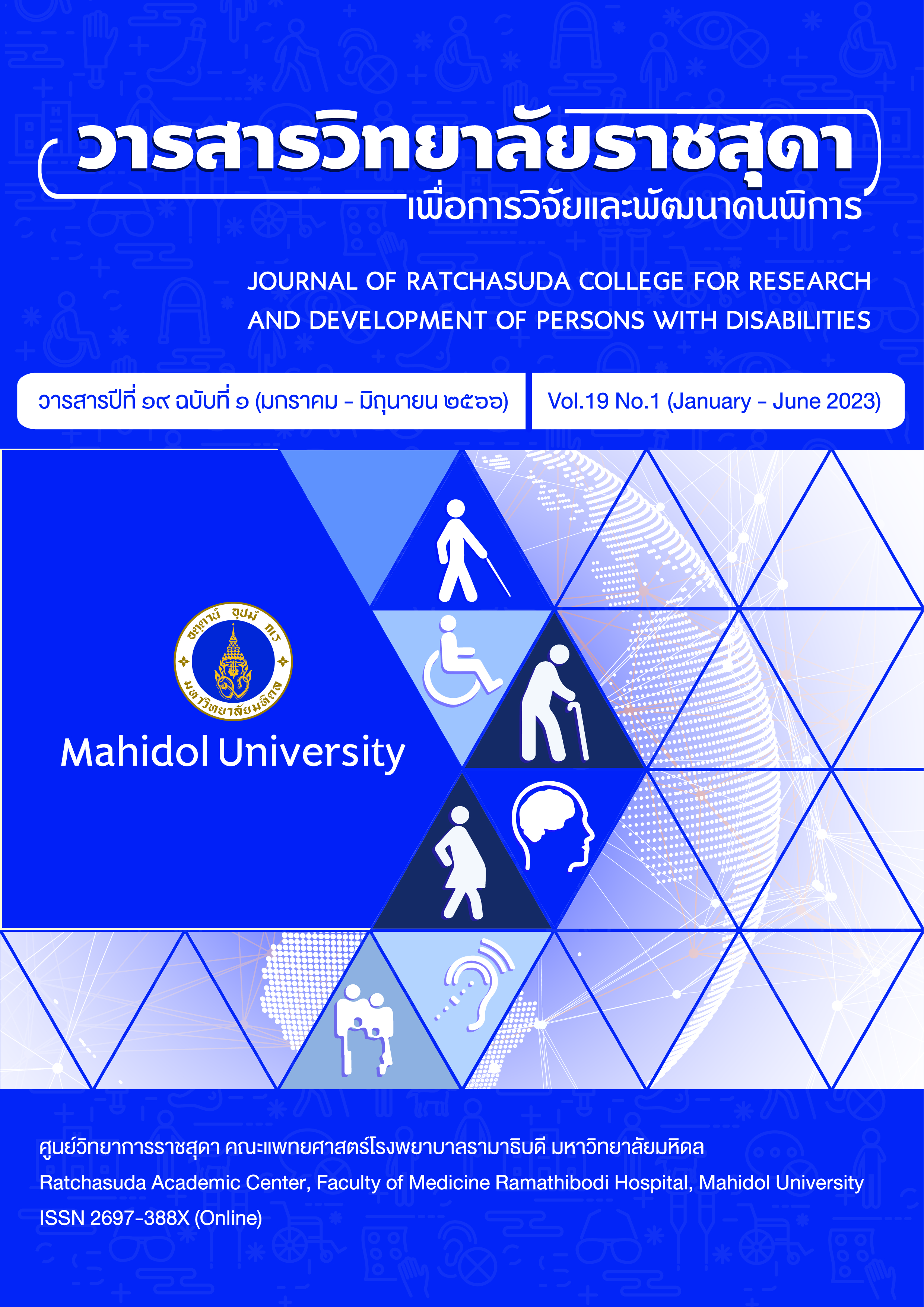The Study of Effectiveness of Auditory, Language and Speech Rehabilitation and Correlating Factors in Children with Cochlear Implantation from 4 Regions
Keywords:
Cochlear Implant (CI), Auditory Verbal, Language RehabilitationAbstract
This research aimed (1) to study on results from hearing, speech and language rehabilitation in children who receive Cochlear Implant (CI), (2) to study factors that may affect rehabilitative capacities, and (3) to determine the minimum average number of sessions required to improve skills. Researchers had screened children who would be suitable for CI and rehabilitation that consisted of 13 children aged 1-4 years. After the operation, all children received rehabilitation one session per week, with 30-60 minutes per session for the duration of 2 years. Speech and language evaluation were conducted 6 times, with one evaluation prior to the operation, and the remaining 5 sessions in post-operation consisted of 1, 3, 6, 12, 24 months after the first rehabilitative session, using assessment for pre-post CI and the first 100 vocabulary checklist, Ling Six Sound Test and CAP scales and Articulation test. Statistical analysis will be analyzed via descriptive, One-way Repeated Measure ANOVA and Multiple Regression. Overall average scores of listening, language and speech clarity (articulation) assessment from CI candidates in 1, 3, 6, 12, 24 months post-operation, 17.9±11.6, 27.7±13.4, 37.2±14.2, 55.3±26.7 and 109.3±82.7, have higher average scores than pre-operation 6.3±9.0 in all ranges with statistical significance (p<0.05). The most prominent factor in average assessment scores is the age, with the average 19.0 scores increased after 1 year of rehabilitation and require at least 4 sessions within a month to improve skills. In conclusion, the screening, operation, and rehabilitation protocols in children who receive CI in this study can be used as the effective model for the screening, operation, hearing skills and speech and language rehabilitation protocols for children with hearing impairment in Thailand, since they are able to cover all important aspects in communication, and also determine the prominent factor to the rehabilitation. It is evident that all candidates yield improved skills and also encourage the multidisciplinary approach and, most importantly, the parents.
Downloads
References
American Speech-Language Hearing Association. (2011). Aural/Audiologic Habilitation for Children. Retrieved from https://www.asha.org/uploadedFiles/AIS-Aural-Audiologic-Habilitation-Children.pdf.
Aussie Deaf Kids. (2015). Enhancing communication with hearing impaired children and wearers of hearing aids. Retrieved from https://www.aussiedeafkids.org.au/enhancing-communication-with-hearing-impaired-children-and-wearers-of-hearing-aids.html.
Bradham, T. S., & Houston, K. T. (2015). Assessing listening and spoken language in children with hearing loss. San Diego: Plural Publishing.
Butterfield, S. A. (1991). Influenceofage, sex,hearing lossand balanceon development of running by deaf children. Retrieved from https://www.ncbi.nlm. nih.gov/ pubmed/1766796.
Butterfield, S. A. & Erising, W. F. (1986). Influenceofage, sex, etiology,and hearing losson balance performance by deaf children. Retrieved from https://www.researchgate.net/publication/19659196_Influence_of_age_sex_etiology_and_hearing_loss_on_balance_performance_by_deaf_children.
Cole, E. B., & Flexer, C. (2011). Children with hearing loss developing listening and talking. San Diego: Plural Publishing.
Cooper, H. (1991). Cochlear implants: a practical guide. London: Whurr Publishers.
Dardarananda, R., Akamanon, C., & Decongkit, S. (1986). Speech disorders. Bangkok: Ruengaew Publishing.
Dickson, N. C. (2013). Track a listening child. Retrieved from https://www.com/0f576aaf-45ce-4256-9b3b 72663bf661/general _ rehabilitationresources _ earlyintervention _ trackalisteningchild%28tlc%29_en_3.31mb.pdf? MOD=AJPERES&CONVERT_TO=url&CACHEID=ROOTWORKSPACE-0f576aaf-45ce-4256-9b3b-e772663bf661-l5rD6NH.
Erber, N. P. (1982). Auditory, visual, and auditory-visual perception of vowels by hearing-impaired children. Journal of Speech, Language, and Hearing Research, 25(1), 100-107.
Estabrooks, W. (2006). Auditory-verbal therapy and practice. Washington DC: Alex Graham Bell Assn for Deaf.
Jerry, L. (1991). Northern: hearing in children. 4th edition. Baltimore: William & Wilkins.
Katz, J. (1994). Handbook of clinical audiology. 4th edition. Maryland: William & Wilkins.
Komin, K. (2008). know the device 'Cochlear implants', the gateway to a sound life Retrieved from http://www.hopetohear.net/special_story1_ci_doctor.html.
Kretschmer, R. R., Kretschmer, L. & W. (1978). Language development and intervention with the hearing impaired. Baltimore: University Park Press.
Lertsukprasert, K. (2007). Congenital hearing loss: Diagnosis & rehabilitation. Bangkok: Kochakorn Publishing.
Lim, S. Y. C., & Simser, J. (2005). Auditory-verbal therapy for children with hearing impairment. Ann Acad Med Singapore, 34(4), 307-312.
Ling, D. (1989). Foundations of spoken language for hearing-impaired children. Washington DC: Alexander Graham Bell Association for the Deaf.
Ling, D. (1976). Speech and the hearing-impaired child: Theory and practice. Washington DC: Alexander Graham Bell Association for the Deaf.
Luangpitakchumpon, P. (2010). Assessing the listening and speaking abilities of deaf children using cochlear implants aged 1 – 5 years. Bangkok: Aekkarnpim Publishing.
Luterman, D., & Kurtzer-White, E. (1999). Identifying hearing loss: Parents' needs. American Journal of Audiology, 8(1) 13-18.
Manochiopinig, S., Pracharitpukdee, N., & Lertsarunyapong, S. (1998). The Articulation Characteristics of Normal Thai Children aged 3 - 10 years Assessing by Using the Thai Articulation Test (TAT). Siriraj Medical Journal, 8(50), 763-769.
Patarapak, S. (2014). Oto-Neurotology. Bangkok: V.Print Publishing
Prathanee, B. (1995). Speech and language disorders. Khonkaen: The handout of Department of Otolaryngology Khonkaen University.
Roland, P. S., Meyerhoff, W. L., & Marple, B. F. (Eds.). (1997). Hearing loss. New York: New York Thieme Medical Publishing.
Saksiriphol, D. (2019). Hearing and speech development in children with hearing impairment. Retrieved from http://rise.swu.ac.th/Portals/184/documents/articles/Developing_ Listening_ and_Spoken_Language_Skills-03.pdf.
Sirindhorn National Medical Rehabilitation Institute. (2020). Manual guidline for operationing screening and auditory verbal language rehabilitation in the child with cochlear implant. Bangkok: Aroon Publishing.
Thammasaeng, M. & Saksiriphol, D. (2007). Using listening to treatment speech problem. Encylopedia of education, 23(40), 40-48.
Thawin, C., Kanchanalarp, C., Lertsukprasert, K., Cheewaruangroj, W., Khantapasuantara, K. & Ruencharoen. S. (2006). Auditory Performance of Cochlear Implant Children Aged 2-5 Years. Retrieved from http://www.ncbi.nlm.nih.gov/pubmed/17205875.
The Royal college of Otolaryngologists Head and Neck Surgeons of Thailand. (2012). The guideline for cochlear implant surgery in Thailand. Bangkok: Chulalongkorn University Printing House.
Tyler, R. S. (1993). Cochlear implants audiological foundations. San Diego: Singular Publishing.
Downloads
Published
How to Cite
Issue
Section
License
Copyright (c) 2023 Ratchasuda Academic Center, Faculty of Medicine Ramathibodi Hospital, Mahidol Universityบทความที่ได้รับการตีพิมพ์เป็นลิขสิทธิ์ของวารสารสถาบันราชสุดาเพื่อการวิจัยและพัฒนาคนพิการ






